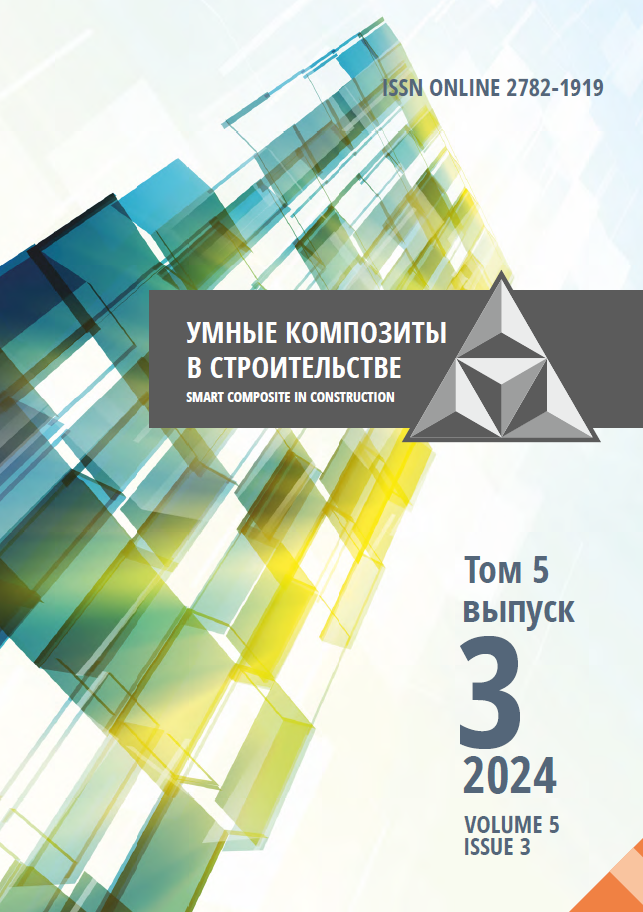from 01.01.1991 until now
Orenburg, Orenburg, Russian Federation
Orenburg, Orenburg, Russian Federation
from 01.01.2004 until now
Orenburg, Orenburg, Russian Federation
Pervious concrete has the ability to permeate water through its structure, which makes it effective in creating drainage systems and culverts. The authors focus on analyzing the dependence of physical and mechanical properties of pervious concrete on formulation factors such as cement consumption, water-cement ratio and polypropylene fibre addition. The authors performed a complete two-factor experiment and regression analysis. It allows to determine the effect of each of the mentioned factors on the density, porosity and strength characteristics of the material. The results of the study show that the density and porosity of concrete samples, flexural and compressive strengths vary mainly with cement consumption. Changing the consumption of polypropylene fibre in the concrete mix has a negligible effect on strength but is important for improving other performance properties such as frost resistance. The study revealed that optimising the composition of pervious concrete, taking into account cement consumption and the addition of polypropylene fibre, allows the production of a construction material with the required strength and porosity values.
pervious concrete, polypropylene fibre, physical and mechanical properties, cement consumption, porosity, compressive and flexural strength
1. Obla, K.H. (2010), "Pervious concrete – An overview", Ind. Concrete J., Vol. 84, no. 8, p. 9.
2. Bakshi, P., Malik, A., Parihar, A.S. and Ahamad, A. (2016), "Pervious Concrete", Int. J. Sci. Res., Vol. 5, no. 4, pp. 98-103.
3. Dash, S. and Kar, B. (2018), "Environment friendly pervious concrete for sustainable construction", IOP Conf. Ser.: Mat. Sci. Eng. IOP Publ., Vol. 410, no. 1, pp. 012005.
4. Tennis, P.D., Leming, M.L. and Akers, D.J. (2004), "Pervious concrete pavements", Vol. 8. Skokie, IL: Portland Cement Association.
5. Skramtaev, B.G. (1931), A new type of warm concrete. In: Alexandrii, I.P., Skramtaev, B.G. Warm Concrete. Leningrad: Publishing Institute of Concrete, pp. 26-35 (in Russian).
6. Skramtaev, B.G. (1933), Concretes of Various Types, Stroyizdat, Moscow (in Russian).
7. Popov, N.A. (1934), Porous Concretes, Construction Industry: Reference Guide, 4, Moscow, pp. 373-374 (in Russian).
8. Konorov, A.B. (1935), Experience with porous concrete, 'Stroitel' [Constructor], no. 3, pp. 5-14 (in Russian).
9. Shcherbina, I.N. (1953), "Prefabricated Drains from Porous Blocks", Inform. Bull. of Gidroproekt [Hydroproject's information book], no. 2, Moscow (in Russian).
10. Minas, A.I. and Pechikin, O.Ya. (1973), "Drainage pipes from porous concrete for use in aggressive environments", Gidrotekhnika i melioratsiya [Hydraulic engineering and melioration], no. 10, pp. 83-86 (in Russian).
11. Dikovskiy, I.A. (1960), "Walls of industrial buildings from porous concrete", Promyshlennoe stroitel'stvo [Industrial construction], no. 4, pp. 54-56 (in Russian).
12. Falikman, V.R. and Sirotin, P.N. (2020), "Pervious concrete: new challenges in the era of sustainable development", Promyshlennoe i grazhdanskoe stroitel'stvo [Industrial and civil engineering], no. 5, pp. 28-35 (in Russian).
13. Nguyen, D., Sebaibi, N., Boutouil, M., Leleyter, L. and Baraud, F. (2014), "A modified method for the design of pervious concrete mix", Construction and Building Materials., Vol. 73, pp. 271-282. Available at: https://doi.org/10.1016/J.CONBUILDMAT.2014.09.088 (accessed 28.04.2024).
14. Zhong, R. and Wille, K. (2015), "Material design and characterization of high performance pervious concrete", Construction and Building Materials, Vol. 98, pp. 51-60. Available at: https://doi.org/10.1016/J.CONBUILDMAT.2015.08.027. (accessed 10.04.2024).
15. Sabnis, G. (2007), "Pervious Concrete for Sustainable Development", pp. 167-190. Available at: https://doi.org/10.1201/B11376-12 (accessed 10.04.2024).
16. Guntakal, S. and Selvan, S. (2017), "Application of pervious concrete for pavements: A rev." Available at: https://doi.org/10.7324/RJC.2017.1011533 (accessed 10.04.2024).
17. Padate, S., Rakshe, P., Waghmare, A., Pachore, S. and Mudawat, V. (2017), "Feasibility of Pervious Concrete in Pavement", Imper. J. Iinterdiscipl. Res. Vol. 3.
18. Kováč, M. and Sičáková, A. (2017), "Pervious concrete as a sustainable solution for pavements in urban areas", Available at: https://doi.org/10.3846/ENVIRO.2017.031 (accessed 02.05.2024).
19. Kuskiwala, A. (2018), "A Study on Pervious Concrete: A Rev.", Int. J. Res. Appl. Sci. Eng. Techn., Vol. 6, pp. 3415 3417. Available at: https://doi.org/10.22214/ijraset.2018.1476 (accessed 10.04.2024).
20. Ab Latif, A., Putrajaya, R. and Ing, D.S. (2023), "A Review of Porous Concrete Pavement: Compressive Strength and Clogging Investigation", J. Adv. Res. Appl. Sci. Eng. Tech.,Vol. 29, no. 3, pp. 128-138. Available at: DOI: https://doi.org/10.37934/araset.29.3.128138 (accessed 09.04.2024).
21. American society for testing and materials. ASTM C1754 / C1754M-12, Standard Test Method for Density and Void Content of Hardened Pervious Concrete (2012), ASTM International, West Conshohocken, PA.
22. GOST 310.4-81. Cements. Methods for determining the limits of strength in bending and compression. (2006), Introduced 1983-07-01. Moscow: IPK Publishing Standards (in Russian).
23. American Concrete Institute. ACI 522R–10: Report on pervious concrete (2010), Farmington Hills, MI.
24. Ahmed, F.B., Mitu, S.M., Biswas, R.K., Ahsan, K.A., Mim, S.M. and Ahmed, S. (2021), "Forecast flexural strength of pervious concrete by SVR", Materials Today: Proceedings, Vol. 45, pp. 5277-5284.
25. Joung, Y. (2010), Evaluation and optimization of pervious concrete with respect to permeability and clogging. Doctoral dissertation, Texas A & M University.
26. Hamoodi, A.Z., Kadim, J.A. and Chkheiwer, A.H. (2021), "Properties of pervious concrete made from graded and single size crushed coarse aggregate", Period. Eng. Nat. Sci., Vol. 9, no. 1. pp. 361-376.
27. Seeni, B.S. and Madasamy, M. (2021), "A review of factors influencing performance of pervious", Građevinar, Vol. 73, no. 10, pp. 1017-1030.
28. Paganggi, W.R., Makmur, A. and Rachmansyah, R. (2021), "Pengaruh Penambahan Serat Polypropylene terhadap Kuat Tekan dan Nilai Permeabilitas pada Beton Berpori", Media munikasi Teknik Sipil, no. 27(1), pp. 135-142. doi: mkts.v27i1.31536.
29. Baskar, I., Thiruvannamalai, M. and Theenathayalan, R. (2019), "Experimental study on mechanical properties of polypropylene fiber reinforced pervious concrete", Int. J. Civ. Eng. Tech, Vol. 10, no. 2, pp. 977-987.
30. Patidar, R. and Yadav, S. (2017), "Experimental study of pervious concrete with polypropylene fiber", Int. Res. J. Eng. Technol., Vol. 4, no. 12, pp. 22-27.
31. Marshinskaya, O.A. (2023), "On the issue of increasing the strength of porous concrete", Shag v nauku [Step into science], no. 4, pp. 64-69 (in Russian).







